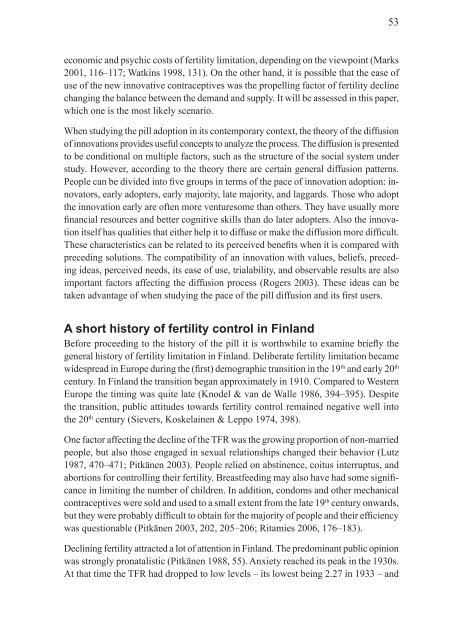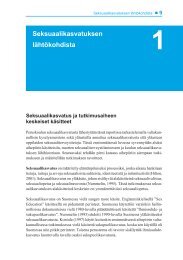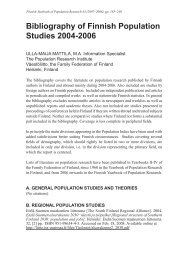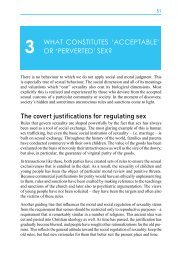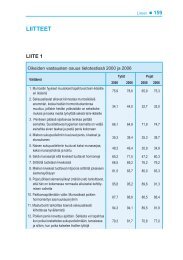Early History of the Oral Contraceptive Pill in Finland ... - Väestöliitto
Early History of the Oral Contraceptive Pill in Finland ... - Väestöliitto
Early History of the Oral Contraceptive Pill in Finland ... - Väestöliitto
Create successful ePaper yourself
Turn your PDF publications into a flip-book with our unique Google optimized e-Paper software.
53<br />
economic and psychic costs <strong>of</strong> fertility limitation, depend<strong>in</strong>g on <strong>the</strong> viewpo<strong>in</strong>t (Marks<br />
2001, 116–117; Watk<strong>in</strong>s 1998, 131). On <strong>the</strong> o<strong>the</strong>r hand, it is possible that <strong>the</strong> ease <strong>of</strong><br />
use <strong>of</strong> <strong>the</strong> new <strong>in</strong>novative contraceptives was <strong>the</strong> propell<strong>in</strong>g factor <strong>of</strong> fertility decl<strong>in</strong>e<br />
chang<strong>in</strong>g <strong>the</strong> balance between <strong>the</strong> demand and supply. It will be assessed <strong>in</strong> this paper,<br />
which one is <strong>the</strong> most likely scenario.<br />
When study<strong>in</strong>g <strong>the</strong> pill adoption <strong>in</strong> its contemporary context, <strong>the</strong> <strong>the</strong>ory <strong>of</strong> <strong>the</strong> diffusion<br />
<strong>of</strong> <strong>in</strong>novations provides useful concepts to analyze <strong>the</strong> process. The diffusion is presented<br />
to be conditional on multiple factors, such as <strong>the</strong> structure <strong>of</strong> <strong>the</strong> social system under<br />
study. However, accord<strong>in</strong>g to <strong>the</strong> <strong>the</strong>ory <strong>the</strong>re are certa<strong>in</strong> general diffusion patterns.<br />
People can be divided <strong>in</strong>to five groups <strong>in</strong> terms <strong>of</strong> <strong>the</strong> pace <strong>of</strong> <strong>in</strong>novation adoption: <strong>in</strong>novators,<br />
early adopters, early majority, late majority, and laggards. Those who adopt<br />
<strong>the</strong> <strong>in</strong>novation early are <strong>of</strong>ten more venturesome than o<strong>the</strong>rs. They have usually more<br />
f<strong>in</strong>ancial resources and better cognitive skills than do later adopters. Also <strong>the</strong> <strong>in</strong>novation<br />
itself has qualities that ei<strong>the</strong>r help it to diffuse or make <strong>the</strong> diffusion more difficult.<br />
These characteristics can be related to its perceived benefits when it is compared with<br />
preced<strong>in</strong>g solutions. The compatibility <strong>of</strong> an <strong>in</strong>novation with values, beliefs, preced<strong>in</strong>g<br />
ideas, perceived needs, its ease <strong>of</strong> use, trialability, and observable results are also<br />
important factors affect<strong>in</strong>g <strong>the</strong> diffusion process (Rogers 2003). These ideas can be<br />
taken advantage <strong>of</strong> when study<strong>in</strong>g <strong>the</strong> pace <strong>of</strong> <strong>the</strong> pill diffusion and its first users.<br />
A short history <strong>of</strong> fertility control <strong>in</strong> F<strong>in</strong>land<br />
Before proceed<strong>in</strong>g to <strong>the</strong> history <strong>of</strong> <strong>the</strong> pill it is worthwhile to exam<strong>in</strong>e briefly <strong>the</strong><br />
general history <strong>of</strong> fertility limitation <strong>in</strong> F<strong>in</strong>land. Deliberate fertility limitation became<br />
widespread <strong>in</strong> Europe dur<strong>in</strong>g <strong>the</strong> (first) demographic transition <strong>in</strong> <strong>the</strong> 19 th and early 20 th<br />
century. In F<strong>in</strong>land <strong>the</strong> transition began approximately <strong>in</strong> 1910. Compared to Western<br />
Europe <strong>the</strong> tim<strong>in</strong>g was quite late (Knodel & van de Walle 1986, 394–395). Despite<br />
<strong>the</strong> transition, public attitudes towards fertility control rema<strong>in</strong>ed negative well <strong>in</strong>to<br />
<strong>the</strong> 20 th century (Sievers, Koskela<strong>in</strong>en & Leppo 1974, 398).<br />
One factor affect<strong>in</strong>g <strong>the</strong> decl<strong>in</strong>e <strong>of</strong> <strong>the</strong> TFR was <strong>the</strong> grow<strong>in</strong>g proportion <strong>of</strong> non-married<br />
people, but also those engaged <strong>in</strong> sexual relationships changed <strong>the</strong>ir behavior (Lutz<br />
1987, 470–471; Pitkänen 2003). People relied on abst<strong>in</strong>ence, coitus <strong>in</strong>terruptus, and<br />
abortions for controll<strong>in</strong>g <strong>the</strong>ir fertility. Breastfeed<strong>in</strong>g may also have had some significance<br />
<strong>in</strong> limit<strong>in</strong>g <strong>the</strong> number <strong>of</strong> children. In addition, condoms and o<strong>the</strong>r mechanical<br />
contraceptives were sold and used to a small extent from <strong>the</strong> late 19 th century onwards,<br />
but <strong>the</strong>y were probably difficult to obta<strong>in</strong> for <strong>the</strong> majority <strong>of</strong> people and <strong>the</strong>ir efficiency<br />
was questionable (Pitkänen 2003, 202, 205–206; Ritamies 2006, 176–183).<br />
Decl<strong>in</strong><strong>in</strong>g fertility attracted a lot <strong>of</strong> attention <strong>in</strong> F<strong>in</strong>land. The predom<strong>in</strong>ant public op<strong>in</strong>ion<br />
was strongly pronatalistic (Pitkänen 1988, 55). Anxiety reached its peak <strong>in</strong> <strong>the</strong> 1930s.<br />
At that time <strong>the</strong> TFR had dropped to low levels – its lowest be<strong>in</strong>g 2.27 <strong>in</strong> 1933 – and


